BIOGRAPHICAL DATA
1930.
Born in London.
1945/7.
Served in the Royal Navy
1948/9.
Studied architecture & structural engineering.
1950/3.
Studied sculpture. St. Martins School of Art, under Frank Martin, Anthony Caro, and Peter King.
1954.
Worked as a model maker at the Natural History Museum, London.
1960/1.
At present working as assistant for Henry Moore. Exhibited at the Portal Gallery, W.1., New Vision Gallery, E.1. and Galllery One, W.1.
Sculpture in private collections Austria, Germany and London.
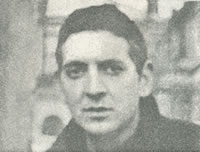
Part of the original Exhibition Catalogue (other artists were featured too) (PDF)
Born 1930 London.
1945 Studied Architecture.
1953 Studied Sculpture, St. Martin's College of Art.
1960 Assistant to Henry Moore.
Teaches at Hornsey College of Art and Bournemouth College of Art.
Exhibitions: New Vision Centre Gallery, Institute of Contemporary Art, Gallery One, Bear Lane Gallery, Oxford.
Collections: Arts Council of Great Britain. Private collections in England and abroad.
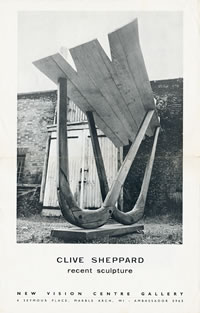
Original Exhibition Folder
New Vision Centre Gallery (PDF)
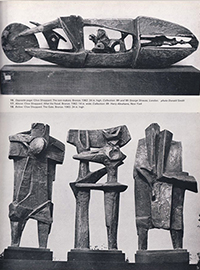
Article in Motif12 Magazine by Maurice de Sausmarez, 1964 (PDF)
Contributed by Abigail Sheppard, 2024
EXHIBITIONS COLLECTIONS PUBLICATIONS
ART & RESEARCH PROJECT (original text by Clive Sheppard, 1972)
BIOGRAPHISCHES
Clive Archangel Sheppard geboren 1930 in London, sein Vater war Silberschmied. Nach den Pflichtschulen Studium von Architektur und Bautechniken. Mit 18 begann er sich für Bildhauerei zu interessieren. Nach 2 Jahren Militärdienst bei der Marine (1951) wurde er mit verschiedenen modernen Künstlern wie Pollock, Cogndon [Anm: William Congdon] bekannt und begann mit unkonventionellen Materialien zu experimentieren. Seinen Lebensunterhalt verdiente er mit „Industrial Design”, hauptsächlich „Exhibition Design”. Damals besuchte er Abendklassen für Bildhauerei und Aktzeichnen. Ab 53 Arbeit am British Museum in der Naturhistorischen Abteilung, wo er Zugang zu fossilen Formen fand. Er verfertigte dort genaueste Modelle nach der Natur und wurde auf diese Weise mit allen ihren Formen vertraut. Zugleich bot ihm die gut eingerichtete Werkstätte des Museums Gelegenheit, mit den verschiedensten Werkstoffen zu arbeiten – Metallen, Wachs, Kunststoffen.
Studium an der St. Martin's School of Art bei Anthony Caro, Begegnung mit Peter King, der zu dieser Zeit an der gleichen Schule unterrichtete, assistierte Peter bei seinen Bronzegüssen.
Studienreisen in Frankreich und Italien, wo ihn eine Ausstellung sardinischer Bronzen sehr beeindruckte. Die Jahre zwischen 57–60 waren ausgefüllt mit unentwegter und leidenschaftlicher Arbeit, die immer individueller wird.
Zu dieser Zeit war Clive Sheppard mit der Graphikerin und Malerin Elisabeth Pearce verheiratet und siedelte sich in „The Abbey Art Centre” in New Barnet an, wo er in das frühere Studio von Peter King (nach dessen Tod 1957) einzog.
1960 wird Clive Sheppard Assistent von Henry Moore.
In dieser Zeit ordnet er seine Erfahrungen, die er in den verschiedenen Techniken gesammelt hat und die verschiedenen großen Einflüsse, die ihm Richtung gegeben haben, seiner eigenen starken Persönlichkeit unter, weist jahrelang jede Möglichkeit auszustellen als „Modesache” zurück. Clive Sheppard ist in London bekannt und geschätzt und zahlreiche Arbeiten von ihm befinden sich in privaten Sammlungen.
Diese Biographie basiert teilweise auf einer von Angela Varga etwa 1960 verfaßten, sie entstand anläßlich einer Reihe von projektierten Gruppenausstellungen mit wechselnden Künstlern des Abbey Art Centre und Peter King (posthum), in einer Galerie in Rom und in Wien, dem Museum für Angewandte Kunst (jetzt MAK). Die Ausstellungen kamen nicht in dieser Weise zustande – Kataloge von Gruppenausstellungen in ähnlichen Konstellationen siehe Presse; Angela Varga hatte jedoch eine Einzelausstellung 1965 im Museum für Angewandte Kunst. Clive Sheppard reiste auch nach Wien für die Ausstellungsplanung mit dem Museumsdirektor Griessmaier und dem Kurator Wilhelm Mrazek, auch wurde er mit Fritz Wotruba bekannt. 1961 war er in ein Projekt im Rahmen der Internationalen Ausstellung des modernen Schmucks www.thegoldsmiths.co.uk involviert, organisiert von der Worshipful Company of Goldsmiths in Zusammenarbeit mit dem Victoria and Albert Museum, wo Wachstücke an berühmte Künstler, wie Picasso, gesandt wurden mit der Idee, die so entstehenden Stücke in der Technik des verlorenen Wachses für diese Ausstellung zu gießen.
Zu dieser Zeit unterrichtete Clive Sheppard am Hornsey College of Art und am Bournemouth College of Art. Er war 1966 Gastkünstler an der Washington University, wo er Sonia Anthony kennenlernte. Er unterrichtete auch an der The Bath Academy of Art (BAA) in Corsham, und, kurz bevor er starb, übernahm er noch eine Position am Sheffield Polytechnic School of Art and Design.
Auftragsarbeiten von Clive Sheppard umfaßten Dioramen für das British Museum, die nach wie vor existieren sollen, auch hat er Werbe-Dioramen im NY Kennedy Airport gestaltet, die erst kürzlich entfernt wurden. Für Science-Fiction Filme hat Clive Sheppard Monster gebaut, wie ein Rieseninsekt, das Menschen aufliest, sowie ein kleines Raumschiff in Kubricks 2001: A Space Odyssey.
BIOGRAPHICAL NOTES
Clive Archangel Sheppard, the son of a silversmith, was born in 1930 in London. After the years of compulsory schooling, he studied architecture and structural engineering. However, at the age of 18 he became interested in sculpture, and after two years of National Service in the Royal Navy, he discovered contemporary artists like Pollock and Congdon and started to experiment with unconventional materials.
He made his principal living at this time from exhibition design. At that time he attended evening classes in sculpting and life drawing. He went on to study at St. Martin's School of Art (1950-1953) under Anthony Caro and met Peter King, who was also teaching there at that time. He assisted him with his bronze castings.
During this period, study trips through France and Italy, including a visit to an exhibition of Sardinian bronzes, made a great impression on him. In 1954 he worked at the Natural History Museum in South Kensington, where he discovered the world of fossil forms and created highly detailed models of natural forms and living creatures. At the same time the well equipped workshop at the museum afforded the opportunity to get acquainted with all kinds of new materials and substances – metals, wax, synthetics. In the years between 1957 and 1960 he was prolific and passionate about his work, which became more and more individual.
Clive Sheppard married Elisabeth Pearce, the printmaker and painter and moved to the Abbey Art Centre, where he lived in the former studio of Peter King (shortly after his death in 1957).
In 1960 Clive Sheppard became assistant to Henry Moore.
This biography is partly based on a biography written by Angela Varga, at around 1960, as part of a series of planned group exhibitions, with selected artists from the Abbey Art Centre and Peter King (posthumously), in a gallery in Rome and in Vienna, at the Museum of Applied Arts 1961 (now MAK). The exhibitions did not take place as envisaged (catalogues from other group exhibitions see press page), but Angela Varga had a solo exhibition 1965 at the Museum of Applied Arts. Clive Sheppard also travelled to Vienna for preparations and meetings with the museum director Griessmaier and curator Mrazek, and he also met Fritz Wotruba. In 1961 he was involved in a project for the International Exhibition of Modern Jewellery www.thegoldsmiths.co.uk, organized by the Worshipful Company of Goldsmiths in association with the Victoria and Albert Museum, sending pieces of wax to famous artists, like Picasso, with the idea to cast them in lost wax technique for the exhibition.
At that time Clive taught at Hornsey College of Art and Bournemouth College of Art. He was visiting artist at Washington University in 1966, where he met Sonia Anthony. He also taught at The Bath Academy of Art (BAA) in Corsham, and, shortly before he died, he took up a position at Sheffield Polytechnic School of Art and Design.
Commercial projects by Clive included the creation of Dioramas for the British Museum (which are said still to be there), monsters for horror movies, and a small spaceship for Kubrick's 2001: A Space Odyssey.
Exhibitions
1960 New Vision Centre Gallery, London
1961 Gallery One, London
1961 "26 Young Sculptors" L.C.A., London
1962 Artists of Today and Tomorrow, Bear Lane Gallery, Oxford
1963 'Three Sculptors" Bear Lane Gallery, Oxford
1964 New Vision Centre Gallery, London
1964 Bradford City Art Gallery
1965 Manchester City Art Gallery
1966 Steinberg Memorial Art Gallery, Washington University. U.S.A.
1968 Cardiff Museum Gallery
1969 Camden Arts Centre
1970 'Towards Sculpture" Eisteddford, Wales
Collections
Mrs. lrena Moore, Herts
Mr. and Mrs. Max Beloff, Oxford
Mr. Emmanuel Harris, London
Mr. and Mrs. George Strauss, London
Mr. Harry Abrams, New York, U.S.A.
Mr. Leslie Lasky, St. Louis, U.S.A.
Mr. Derek Coleman
Arts Council of Great Britain
Steinberg Collection, Washington University, U.S.A.
Manfred Mautner-Markhof, Austria
Publications
Motif 12; Four British Sculptors: Richmond, Stocker, Sheppard, Hatwell
by Maurice de Sausmarez
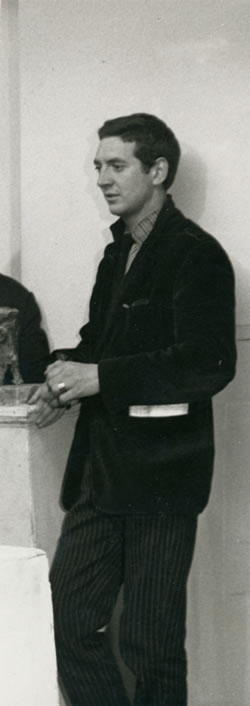
Studied Building and Architecture
1949 Engaged in exhibition design
1950 National Seruice
1952 Natural History Museum
Worked with Antony Caro
1955 Abbey Arts Centre
1960 Assistant to Henry Moore
1966 Visiting Artist
1967 Newport College of Art
Hornsey College of Art
1969 Bath Academy of Art,
1973 Sheffield Polytechnic
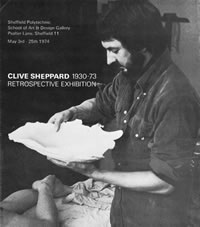
Original Exhibition Catalogue
Sheffield Polytechnic School of Art & Design Gallery (PDF)
Contributed by Daniel C. Anthony, 2015
An idea for the Winston Churchill Memorial Trust for which he was interviewed;
Starting at Darwin I would like to explore extensively the primitive culture of the Aborigine in Arnhem Land. This would include visiting reserves, nomadic communities and archeological sights Ð recording by drawing, photography and tape recording the rituals, ritualistic objects and aftifacts of the aborigine.
The purpose would be to study the relationship of what remains of the primitive culture that exists in parallel with a contemporary one; what effect it has and has had on the Australian painter and sculptor. ln pursuit of this, I would visit the cultural centres in Southern Australia, Sidney, Melbourne, Adelaide and to meet contemporary sculptors and painters working in Australia today.
ln direct reference to my own work, the experience would enable me to feel the relationship of space and scale in relation to landscape and the relevance of making sculpture without the references that I normally, consciously draw on. those of the environment dominated by urban and industrial society of art history and of seeing the art of the primitive in the context of museums or books.
I would like to lecture and show the material I had gathered in order to stimulate interest in another kind of environment and culture.
Clive Sheppard 1972
kunstschau home
webdesign © 2014 by Iby-Jolande Varga
www.filmkunst.at